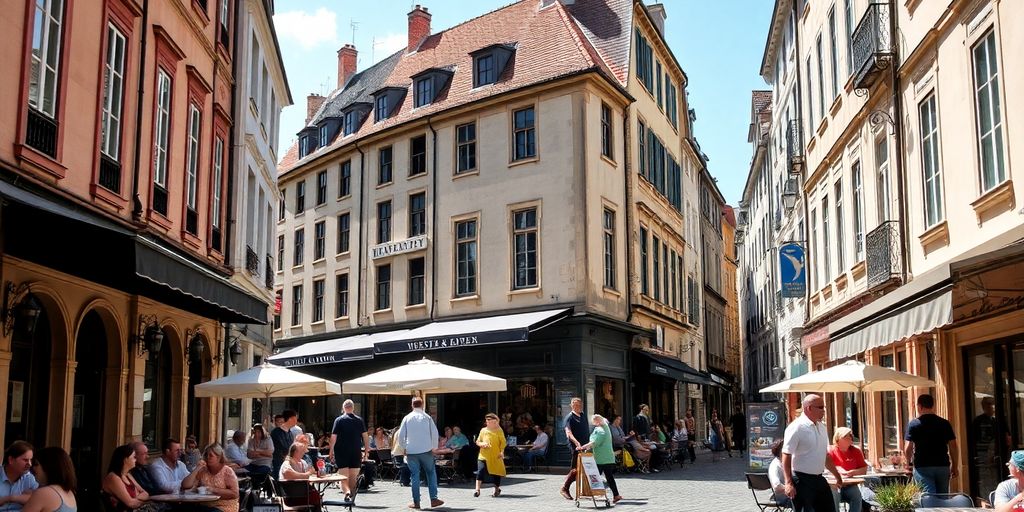Why is Europe Better than the USA? A Comparative Analysis of Quality of Life and Culture

When it comes to quality of life and culture, Europe often gets the nod over the USA. While both regions have their own unique perks, many people argue that Europe offers a richer cultural experience, better work-life balance, and more comprehensive social welfare systems. This article explores why some believe Europe is a better place to live than the USA, focusing on various aspects such as culture, work-life balance, social systems, and more.
Key Takeaways
- Europe is often seen as having a richer cultural heritage, with a deep history in art, music, and literature.
- Work-life balance is generally better in Europe, with more vacation time and flexible work hours.
- Social welfare systems in Europe provide more comprehensive healthcare and social support to citizens.
- Environmental sustainability is a priority in Europe, with significant efforts towards renewable energy and conservation.
- Public transportation in Europe is efficient and widely accessible, making it easier for people to get around.
Cultural Richness and Diversity
Artistic Heritage and Influence
Europe’s artistic legacy is like a living museum, with its cobblestone streets echoing tales of the past. From the Renaissance masterpieces of Italy to the avant-garde movements in France, European art has been a beacon of creativity. The continent’s influence on global art is undeniable, shaping everything from painting and sculpture to architecture and design. European cities boast an abundance of museums, galleries, and historical sites, each narrating a unique story of cultural evolution.
Culinary Traditions and Innovations
When it comes to food, Europe is a tapestry of flavors. Each region offers its own culinary delights, from the hearty stews of Ireland to the delicate pastries of France. European cuisine isn’t just about tradition; it’s also about innovation. Chefs across the continent are constantly experimenting, blending traditional recipes with modern techniques. This fusion of old and new keeps European cuisine vibrant and exciting.
Festivals and Celebrations
Europeans know how to celebrate, and their festivals are a testament to that. Whether it’s the vibrant carnival in Venice or the somber yet beautiful Semana Santa in Spain, these events are a feast for the senses. They bring communities together, celebrating not just religious or historical occasions, but also the simple joy of life. These festivals are a chance for locals and visitors alike to immerse themselves in the rich tapestry of European culture.
Europe’s cultural diversity is a treasure trove of experiences, offering a glimpse into a world where history and modernity coexist in harmony. From art and food to festivals, every aspect of life here is a celebration of its rich heritage.
Work-Life Balance and Leisure

Paid Time Off and Vacation Policies
Europeans generally enjoy more generous paid time off than their American counterparts. Countries like France and Germany offer at least four weeks of paid vacation annually, while the U.S. lacks a federal mandate for paid leave. This difference reflects a broader cultural attitude where leisure and relaxation are prioritized over relentless work schedules. In Europe, taking time off is often seen as essential for maintaining productivity and personal well-being.
Work Hours and Flexibility
In the EU, there’s a legal cap on the workweek at 48 hours, promoting a healthier work-life balance. In contrast, many Americans find themselves working over 40 hours weekly. This disparity highlights how Europeans prioritize leisure time more than Americans, who often struggle to take time off due to work commitments. Flexible work arrangements, like part-time roles, are more common in Europe, offering individuals the chance to balance work with personal pursuits.
Leisure Activities and Lifestyle
Europeans tend to lead lifestyles that emphasize leisure and cultural activities. Whether it’s spending a lazy afternoon in a café or attending local festivals, leisure is woven into the fabric of daily life. In contrast, the American lifestyle often centers around work, with less emphasis on downtime. This cultural difference underscores the varying attitudes towards work-life balance in the tech industry between Europe and America, where Europeans often enjoy a more relaxed pace of life.
Social Welfare and Healthcare Systems
Universal Healthcare Access
In Europe, universal healthcare is a standard feature, providing comprehensive medical services to all citizens regardless of their financial status. This system ensures that everyone has access to necessary medical care without the fear of crippling costs. In contrast, the U.S. healthcare system is largely privatized, with access often tied to employment and insurance plans. Many European countries are celebrated for their healthcare systems, with nations like France and Germany frequently topping lists of top countries renowned for their exceptional healthcare systems.
Social Safety Nets and Support
European countries generally have robust social safety nets, designed to support citizens through various life challenges. These systems include unemployment benefits, pensions, and family support services. Such comprehensive support structures help reduce poverty and inequality, fostering a more inclusive society. In the U.S., social safety nets exist but are often less extensive, with eligibility criteria that can exclude many in need.
Quality of Life and Well-being
The emphasis on social welfare in Europe contributes significantly to the overall quality of life. Europeans often enjoy longer life expectancies and lower rates of poverty, thanks to these well-structured social systems. The well-being of citizens is a priority, with policies aimed at ensuring a balanced life. In the U.S., while there are efforts to improve quality of life, disparities remain more pronounced, partly due to less comprehensive social welfare systems.
Europe’s approach to healthcare and social welfare highlights a commitment to equitable access and support, fostering a society where well-being is a fundamental right rather than a privilege.
Environmental Sustainability and Green Initiatives
Renewable Energy Adoption
Europe’s commitment to renewable energy is truly something else. Countries like Germany and Denmark have made impressive strides in wind and solar power. In fact, Europe leads the world in renewable energy adoption, with nearly 40% of its electricity coming from renewable sources. This shift isn’t just about tech; it’s a cultural movement towards sustainable living. People are more aware of their energy consumption and its impact on the planet.
Sustainable Urban Planning
Cities across Europe are embracing sustainable urban planning. Look at Amsterdam, with its extensive cycling paths, or Copenhagen, which aims to be carbon neutral by 2025. These cities are designed to reduce carbon footprints and improve quality of life. They’re focusing on public transport, green spaces, and energy-efficient buildings. It’s about creating environments that are both livable and environmentally friendly.
Conservation Efforts and Policies
Europe takes conservation seriously. The EU has implemented strict policies to protect biodiversity and natural habitats. Countries are working hard to preserve their unique ecosystems. From the expansive forests of Finland to the diverse marine life in the Mediterranean, conservation is a priority. These efforts are crucial for maintaining the delicate balance of our planet’s ecosystems.
Europe’s approach to environmental sustainability is not just about policies and technologies. It’s a holistic view that integrates cultural values, economic strategies, and community engagement to create a sustainable future for all.
Education and Lifelong Learning
Higher Education Opportunities
Europe is home to some of the world’s oldest and most prestigious universities, offering a wide range of programs and research opportunities. European universities often have lower tuition fees compared to their American counterparts, which makes education more accessible to a broader audience. In countries like Germany and Norway, public universities even offer free tuition for both domestic and international students. This affordability allows students to focus on their studies without the looming pressure of student debt.
Vocational Training and Skills Development
In Europe, vocational training is highly valued, providing students with practical skills that are directly applicable to the workforce. Countries like Germany have a strong apprenticeship system, where students split their time between classroom instruction and hands-on work experience. This system ensures that graduates are job-ready and equipped with the skills employers need. The emphasis on vocational training helps reduce youth unemployment and matches education with market demands.
Cultural and Educational Exchange Programs
Europe promotes cultural and educational exchanges through programs like Erasmus+, which encourages students to study abroad within the EU. These exchanges allow students to experience different cultures, languages, and educational systems, broadening their horizons and fostering a sense of European unity. Such programs not only enhance personal growth but also improve employability by developing language skills and cultural awareness.
Education in Europe is not just about acquiring knowledge; it’s about building a community that values learning throughout life. Programs and policies are designed to ensure that everyone, regardless of age, has the opportunity to learn and grow.
Public Transportation and Infrastructure

Efficiency and Accessibility
Europe is famous for its efficient and accessible public transport systems. Many cities boast extensive networks of trains, buses, and trams that make getting around a breeze. For instance, cities like Berlin and Paris have metro systems that are not only punctual but also cover vast areas, allowing residents to travel without the need for a car. This level of accessibility is a major advantage for people living in urban areas, reducing the reliance on personal vehicles and promoting a more sustainable lifestyle.
Urban Mobility Solutions
European cities are pioneers in urban mobility solutions. From bike-sharing programs to pedestrian-friendly street designs, these cities encourage eco-friendly transportation. Amsterdam is a classic example, where cycling is integrated into daily life. Many cities are also investing in electric buses and trams to cut down on emissions. This focus on sustainable transport solutions is key to reducing urban congestion and improving air quality.
Investment in Infrastructure Development
Investment in infrastructure is a priority in Europe, with a significant focus on maintaining and upgrading transport networks. Countries invest heavily in rail systems, ensuring they are modern and efficient. For example, the high-speed trains in France and Spain connect major cities quickly and comfortably. This commitment to infrastructure not only supports economic growth but also enhances the quality of life for residents.
Europe’s approach to public transport and infrastructure highlights a commitment to sustainability and efficiency, offering a model that many other regions could learn from. The integration of modern technology and a focus on accessibility and environmental impact make European cities leaders in urban planning and development.
Conclusion
So, when it comes down to it, the debate over whether Europe or the USA offers a better quality of life and culture is pretty complex. Both have their perks and drawbacks. Europe might win some folks over with its laid-back lifestyle, rich history, and emphasis on leisure. Meanwhile, the USA’s fast-paced environment, economic opportunities, and cultural diversity appeal to others. It really boils down to what you value more in life. Whether you’re drawn to Europe’s charm or America’s dynamism, both continents offer unique experiences that can enrich your life in different ways. In the end, it’s all about personal preference and what you want out of your day-to-day living.
Frequently Asked Questions
Why is Europe considered culturally rich?
Europe is known for its diverse cultures, languages, and traditions. It has a long history of art, music, and literature that has influenced the world.
How does work-life balance differ in Europe compared to the USA?
In Europe, people often enjoy more vacation days and shorter workweeks, allowing for a better balance between work and personal life.
What makes European healthcare systems unique?
Many European countries offer universal healthcare, meaning everyone has access to medical services, often at little or no cost.
Why is Europe seen as a leader in environmental sustainability?
Europe invests heavily in renewable energy and sustainable practices, aiming to reduce pollution and protect the environment.
How is education different in Europe?
Europe offers a range of higher education opportunities, often with lower tuition fees, and emphasizes lifelong learning and skills development.
What are the benefits of public transportation in Europe?
European cities often have efficient and accessible public transportation systems, reducing the need for cars and helping to decrease traffic and pollution.








Responses